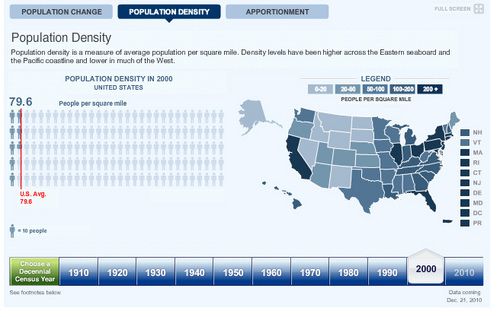By this time tomorrow, we’ll know whether Minnesota is losing one of its eight congressional seats.
Census data is to be released which will determine how many seats the state should have in Congress. The latest word is if Minnesota holds onto all of its congressional seats, it will do so barely.
Here’s a great map from the Census’ Web site that explains the population shift. Find the one you can play with here, this one is just an image.
What does this tell us? That Minnesota and the rest of the Midwest isn’t building population fast enough to sustain whatever influence it has in Congress, and hasn’t been for a long time.
It also shows that we badly trail the national average in the number of people per member of Congress.
What happens if Minnesota loses a seat? The Legislature will take a crack at redrawing district lines. Now that both houses are under Republican control, it may be less acrimonious than usual. It also may be difficult to knock off a Democrat in the process, there are only four of them left. Two of them are in the Twin Cities — Rep. Keith Ellison and Rep. Betty McCollum — and it’s unlikely any district can be drawn that’s going to turn either of the city’s into non-Democrat strongholds.
Keep in mind that the state’s congressional district have to be roughly equal in population. Adding territory from a neighboring Republican district is as likely — or more likely — to result in one less Republican member of Congress.
The other two Democrats — Tim Walz and Collin Peterson — already have huge amounts of territory in their district. It might be possible to combine, say, pieces of Rep. John Kline’s 2nd District with Rep. Tim Walz’s 1st District, but that also creates a district bigger than some states. And, besides, Rochester — in Walz’s district — is actually gaining population, which might make it dicey to carve into Kline’s.
Peterson could be a target. His district could expand to include not only more of the Republican-leaning 6th District, but the heavy-Republican-leaning portions of the 6th District. Or he could pick up some of the Iron Range, which probably wouldn’t affect new Rep. Chip Cravaack much since his district figures to become more suburban Twin Cities influenced.
If the state doesn’t lose any congressional seats, the 6th District will likely change shape. Why? Because the 6th District is always ground zero in redistricting. And if Rep. Michele Bachmann decides to run against Sen. Amy Klobuchar, it’d be an open seat.
It’s quite a game, which is why it’s perfect to be quite a game. In the last redistricting battle, USC’s Annenberg Center created The ReDistricting Game. It’s still a great tool, and helps to explain why gerrymandering is only a small part of the, ummm, game.

